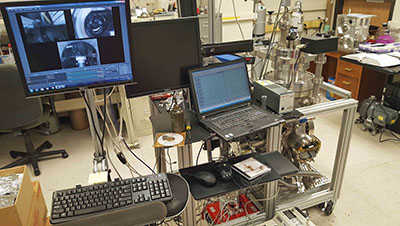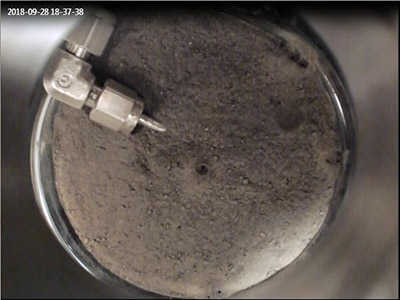Background
The need for this research was based on mounting evidence of volatiles at the lunar surface (LCROSS) and previous Apollo experiments (CCGE) that detected high local pressures and outgassing from astronaut spacesuits. Volatiles at the lunar surface not only have origins from both above and below the lunar surface, but also provide useful resources for long-term human exploration, operations, and habitation. Such volatiles represent an important part of the current international space development effort known as in situ resource utilization (ISRU) that seeks to reduce space mission costs by exploiting local resources found near the surface of solar system bodies being explored. Understanding the origins, trapping, and behavior of these lunar volatiles demands laboratory simulation of the conditions of their particle-entrapped, extreme high vacuum environment as closely as possible. This required an analog laboratory system for conducting experiments on the diffusion of gases relevant to strategic knowledge gaps in our understanding of the transport of volatiles at and through the lunar surface that have resulted in the inventory of volatiles thus far observed.
Approach
 Figure 1: LAVA system showing three camera views of the sample (left), mass spectra of the chamber volume (center), and the chamber with gate valve on top (right).
Figure 1: LAVA system showing three camera views of the sample (left), mass spectra of the chamber volume (center), and the chamber with gate valve on top (right). The objective of this work was to construct a laboratory space environment system capable of simulating gas diffusion through a 0.5-meter column of the lunar surface. The prototype laboratory system, known as the Lunar Advanced Vacuum Apparatus (LAVA), consisted of a 50 cm graduated cylinder containing approximately 2.6 liters of the canonical JSC-1A lunar soil simulant monitored in three locations by USB 1080p video cameras. A gas line to the column base was inserted prior to filling the cylinder with sample. The column was successfully evacuated to rough vacuum using a mechanical roughing pump, followed by a small turbomolecular pump which produced a hard vacuum, at which point a magnetically levitated turbopump was able to safely bring the system to high vacuum once the danger of mobile simulant grains had been greatly diminished. A gate valve beneath the top multi-ported flange permits isolation of this top flange for switch out of existing hardware and installation of future mechanical and optical probes or drills (Figure 1).
Accomplishments
 Figure 2: This photo produced by the video camera above the simulant column shows vent pores in the upper surface of the material. These features were produced by trapped atmosphere outgassing from the bulk material during the initial chamber evacuation. Ejected dust visible on the edge of the graduated cylinder (upper right) was produced by the finest fraction of dust contained within each tiny gas ejecta plume. Similar, short-lived features are likely to occur at the lunar surface from outgassing triggered during moonquakes.
Figure 2: This photo produced by the video camera above the simulant column shows vent pores in the upper surface of the material. These features were produced by trapped atmosphere outgassing from the bulk material during the initial chamber evacuation. Ejected dust visible on the edge of the graduated cylinder (upper right) was produced by the finest fraction of dust contained within each tiny gas ejecta plume. Similar, short-lived features are likely to occur at the lunar surface from outgassing triggered during moonquakes. During evacuation, care was taken to reduce the system pressure from atmosphere at a rate in pressure drop of no greater than 1 Torr/s. However, trapped atmospheric gases produced plumes of ejected fines observed by the camera mounted above the simulant surface (Figure 2). No gas eruption was observed once the chamber had reached pressures below 1 Torr, but subsurface venting of gases such as radiogenic 40Ar are likely to produce similar short-lived features at the lunar surface triggered by moonquakes. Fundamental diagnostics of the system are currently under way to characterize the behavior of various gas species. LAVA has thus far been used as a space environment laboratory resource supporting two NASA proposals, and our intent is to propose a second-generation system to NASA for conducting much more advanced ISRU-related experiments that would include mass spectrometry during simultaneous laser ablation, piezoelectric probing, drilling, and other mechanical and optical techniques.
